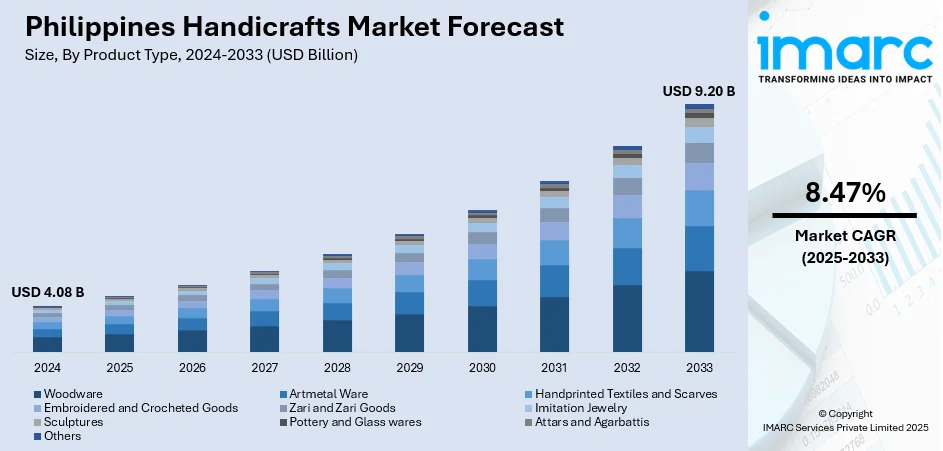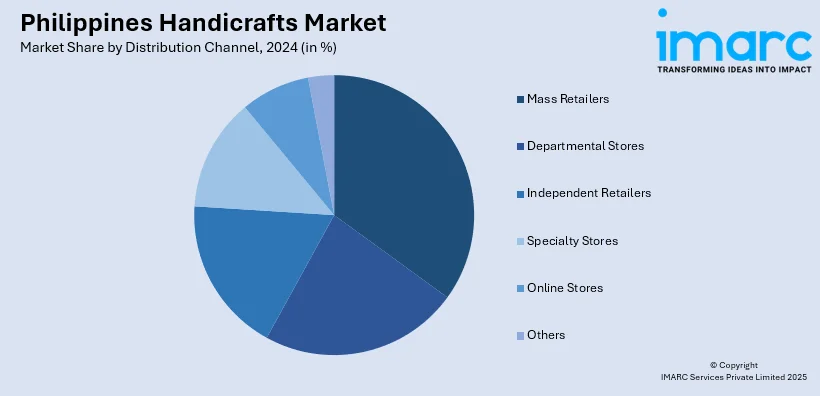
Philippines Handicrafts Market Size, Share, Trends and Forecast by Product Type, Distribution Channel, End Use, and Region, 2025-2033
Philippines Handicrafts Market Overview:
The Philippines handicrafts market size reached USD 4.08 Billion in 2024. Looking forward, the market is projected to reach USD 9.20 Billion by 2033, exhibiting a growth rate (CAGR) of 8.47% during 2025-2033. The market is driven by rich cultural traditions, robust tourism, and global demand for eco-friendly, handcrafted goods. Philippines handicrafts market share continues to grow due to sustainable practices and modern design collaborations.
|
Report Attribute
|
Key Statistics
|
|---|---|
|
Base Year
|
2024
|
|
Forecast Years
|
2025-2033
|
|
Historical Years
|
2019-2024
|
| Market Size in 2024 | USD 4.08 Billion |
| Market Forecast in 2033 | USD 9.20 Billion |
| Market Growth Rate 2025-2033 | 8.47% |
Philippines Handicrafts Market Trends:
Sustainable and Natural Materials
Sustainability plays a major role in Philippines handicrafts market growth, with artisans focusing on natural materials like abaca, bamboo, coconut shells, and rattan. From furniture to home décor, these environmentally friendly products are becoming increasingly popular in both domestic and foreign markets. Eco-conscious consumers are especially drawn to handwoven baskets, eco-friendly matting, and eco-friendly packaging. Through certifications and training programs, the public and private sectors are urging craftspeople to embrace sustainable methods. These handmade, ecological products are becoming more valued in international markets, particularly in the U.S. and Europe. In addition to improving environmental responsibility, this focus on green industry boosts the nation's export competitiveness. For instance, the Philippines made its historic debut at Révélations Paris 2025, held from May 21–25 at the Grand Palais, showcasing contemporary crafts and designs to over 37,000 expected visitors. Supported by the Design Center of the Philippines, the exhibit featured six innovative pieces from eight Filipino designers, blending tradition, sustainability, and modern creativity.

To get more information on this market, Request Sample
Fusion of Heritage and Modern Aesthetics
By fusing traditional methods like capiz shell artistry, wood carving, and banig weaving with modern patterns, Filipino handicrafts are becoming progressively sophisticated. Younger consumers and foreign buyers who are looking for both cultural authenticity and practicality find these updated products appealing. Innovative goods with a strong cultural identity have resulted from partnerships between international brands and local artisans. The popularity of these fusion goods is further demonstrated by the rising demand for handcrafted luxury fashion accessories and home décor. One of the main reasons for the Philippines' handicrafts market's continuous expansion is this blending of tradition and contemporary. For instance, the Interior & Design Manila 2025 trade show highlighted the resilience of Philippine artisans producing handmade tiles, eco-friendly lamps, and woven goods. Brands like Machuca Baldozas, Hacienda Crafts, and Azcor cater to premium markets valuing authenticity, sustainability, and cultural heritage. The event underscored strong demand for bespoke, high-quality interior products.
Philippines Handicrafts Market Segmentation:
IMARC Group provides an analysis of the key trends in each segment of the market, along with forecasts at the region/country level for 2025-2033. Our report has categorized the market based on product type, distribution channel, and end use.
Product Type Insights:
- Woodware
- Artmetal Ware
- Handprinted Textiles and Scarves
- Embroidered and Crocheted Goods
- Zari and Zari Goods
- Imitation Jewelry
- Sculptures
- Pottery and Glass Wares
- Attars and Agarbattis
- Others
The report has provided a detailed breakup and analysis of the market based on the product type. This includes woodware, artmetal ware, handprinted textiles and scarves, embroidered and crocheted goods, zari and zari goods, imitation jewelry, sculptures, pottery and glass wares, attars and agarbattis, and others.
Distribution Channel Insights:

- Mass Retailers
- Departmental Stores
- Independent Retailers
- Specialty Stores
- Online Stores
- Others
A detailed breakup and analysis of the market based on the distribution channel have also been provided in the report. This includes mass retailers, departmental stores, independent retailers, specialty stores, online stores, and others.
End Use Insights:
- Residential
- Commercial
The report has provided a detailed breakup and analysis of the market based on the end use. This includes residential and commercial.
Regional Insights:
- Luzon
- Visayas
- Mindanao
The report has also provided a comprehensive analysis of all the major country markets, which include Luzon, Visayas, and Mindanao.
Competitive Landscape:
The market research report has also provided a comprehensive analysis of the competitive landscape. Competitive analysis such as market structure, key player positioning, top winning strategies, competitive dashboard, and company evaluation quadrant has been covered in the report. Also, detailed profiles of all major companies have been provided.
Philippines Handicrafts Market Report Coverage:
| Report Features | Details |
|---|---|
| Base Year of the Analysis | 2024 |
| Historical Period | 2019-2024 |
| Forecast Period | 2025-2033 |
| Units | Billion USD |
| Scope of the Report |
Exploration of Historical Trends and Market Outlook, Industry Catalysts and Challenges, Segment-Wise Historical and Future Market Assessment:
|
| Product Types Covered | Woodware, Artmetal Ware, Handprinted Textiles and Scarves, Embroidered and Crocheted Goods, Zari and Zari Goods, Imitation Jewelry, Sculptures, Pottery and Glass Wares, Attars and Agarbattis, Others |
| Distribution Channels Covered | Mass Retailers, Departmental Stores, Independent Retailers, Specialty Stores, Online Stores, Others |
| End Uses Covered | Residential, Commercial |
| Regions Covered | Luzon, Visayas, Mindanao |
| Customization Scope | 10% Free Customization |
| Post-Sale Analyst Support | 10-12 Weeks |
| Delivery Format | PDF and Excel through Email (We can also provide the editable version of the report in PPT/Word format on special request) |
Key Questions Answered in This Report:
- How has the Philippines handicrafts market performed so far and how will it perform in the coming years?
- What is the breakup of the Philippines handicrafts market on the basis of product type?
- What is the breakup of the Philippines handicrafts market on the basis of distribution channel?
- What is the breakup of the Philippines handicrafts market on the basis of end use?
- What is the breakup of the Philippines handicrafts market on the basis of region?
- What are the various stages in the value chain of the Philippines handicrafts market?
- What are the key driving factors and challenges in the Philippines handicrafts market?
- What is the structure of the Philippines handicrafts market and who are the key players?
- What is the degree of competition in the Philippines handicrafts market?
Key Benefits for Stakeholders:
- IMARC’s industry report offers a comprehensive quantitative analysis of various market segments, historical and current market trends, market forecasts, and dynamics of the Philippines handicrafts market from 2019-2033.
- The research report provides the latest information on the market drivers, challenges, and opportunities in the Philippines handicrafts market.
- Porter's five forces analysis assist stakeholders in assessing the impact of new entrants, competitive rivalry, supplier power, buyer power, and the threat of substitution. It helps stakeholders to analyze the level of competition within the Philippines handicrafts industry and its attractiveness.
- Competitive landscape allows stakeholders to understand their competitive environment and provides an insight into the current positions of key players in the market.
Need more help?
- Speak to our experienced analysts for insights on the current market scenarios.
- Include additional segments and countries to customize the report as per your requirement.
- Gain an unparalleled competitive advantage in your domain by understanding how to utilize the report and positively impacting your operations and revenue.
- For further assistance, please connect with our analysts.
 Request Customization
Request Customization
 Speak to an Analyst
Speak to an Analyst
 Request Brochure
Request Brochure
 Inquire Before Buying
Inquire Before Buying




.webp)




.webp)












